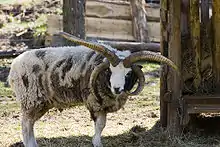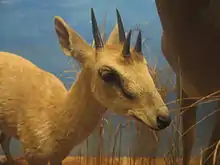Polycerate
Polycerates (meaning "many-horned") are animals with more than two horns.

Cattle
Cattle can have as many as six horns, and occasionally more.
Sheep
Polycerate sheep breeds include the Hebridean, Icelandic,[1] Jacob,[2] Manx Loaghtan, Boreray and the Navajo-Churro. One example of a polycerate Shetland sheep was a ram kept by US President Thomas Jefferson for several years in the early 19th century in front of the White House. In the spring of 1808 this ram attacked several people who had taken shortcuts across the square, injuring some and actually killing a small boy.[3] Because of selective breeding, polycerate sheep are increasingly rare in the British Isles[4] and Spain,[5] but some breeds can still be found in Asia.[6] One example is the black-faced sheep of Tibet.[7]
Goats
There have been incidents of polycerate goats (having as many as eight horns),[8] although this is a genetic rarity thought to be inherited. The horns are most typically removed in commercial dairy goat herds, to reduce the injuries to humans and other goats.
4 horns are the norm for the Austrian goat breed Vierhornziege (four-horned goat). [9]
Wildlife

Antelopes also can be polycerate, for example, the blue wildebeest (Connochaetes taurinus). Both sexes normally possess one pair of large curved horns.[10]
Mythology
Cerastes, a legendary Greek horned serpent, is sometimes described with two horns or with four small ones.
References
- Ryan, E. E. (2011). The Odd Saga of the American and a Curious Icelandic Flock. Charleston, S.C.: CreateSpace. ISBN 9781466383357.
- Glenday, Craig (30 April 2013). Guinness World Records 2013. Bantam Books. p. 81. ISBN 978-0-345-54711-8.
- "Sheep - Thomas Jefferson's Monticello". Monticello.org. Retrieved 17 December 2020.
- Low, David (1845). On the Domesticated Animals of the British Islands: Comprehending the Natural and Economical History of Species and Varieties; the Description of the Properties of External Form; and Observations on the Principles and Practice of Breeding. Longman, Brown, Green & Longmans. p. 39.
- Shuttle, Spindle and Dyepot. Handweavers Guild of America, Incorporated. 1981.
- Agricultural & Horticultural Society of India (1846). Journal. p. 206.
- Asiatic Society (Calcutta, India) (1848). Journal of the Asiatic Society of Bengal. Bishop's College Press. p. 1005.
- Kim Pezza (26 November 2013). Backyard Farming: Raising Goats: For Dairy and Meat. Hatherleigh Press. pp. 112–. ISBN 978-1-57826-474-2.
- various rare farm animal breeds at Schloss Hof in Austria including Vierhornziege
- Ackermann, R. R.; Brink, J. S.; Vrahimis, S.; De Klerk, B. (29 October 2010). "Hybrid wildebeest (Artiodactyla: Bovidae) provide further evidence for shared signatures of admixture in mammalian crania". South African Journal of Science 106 (11/12): 1–4.